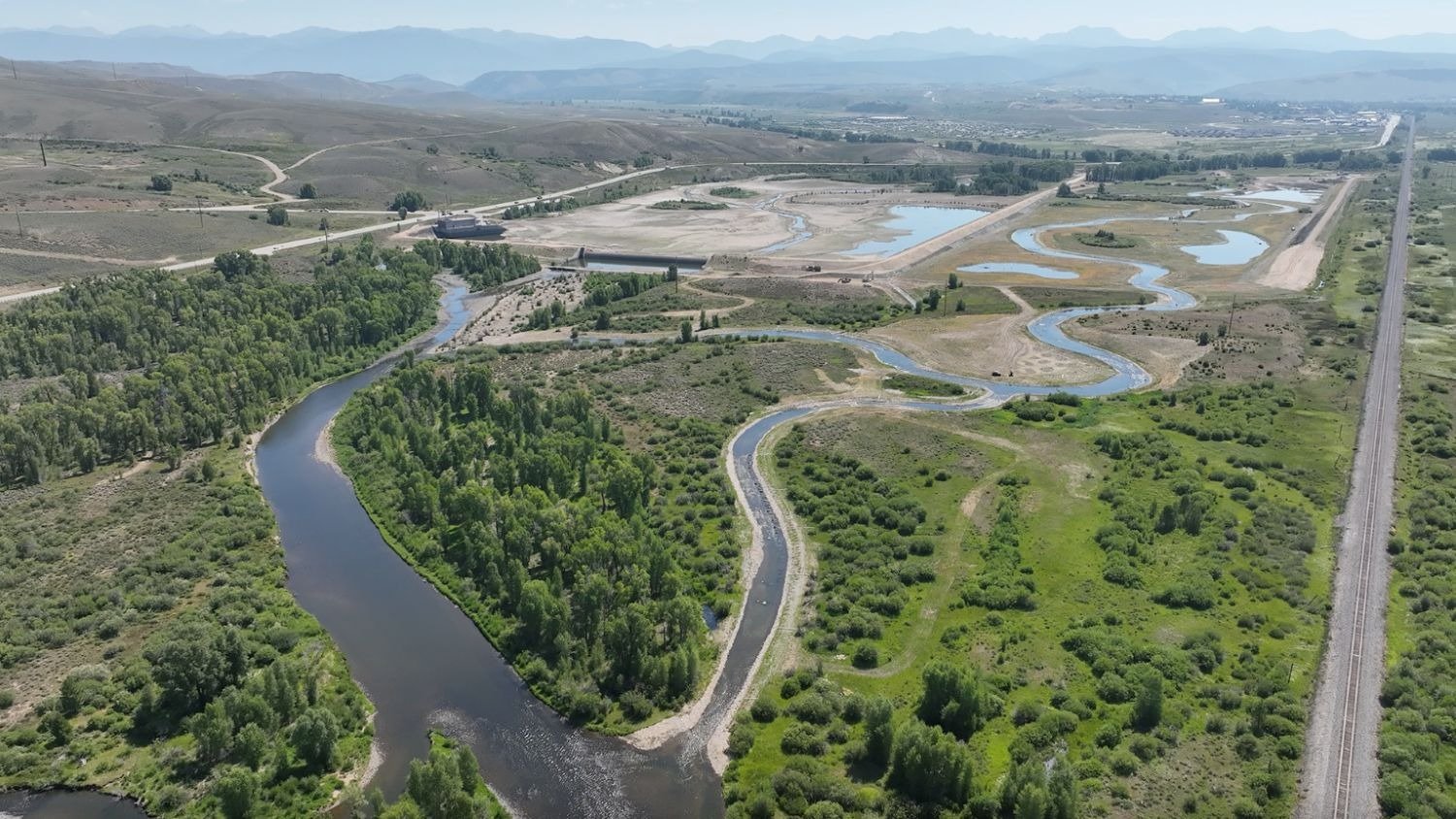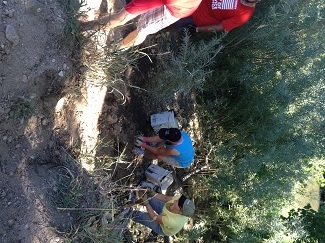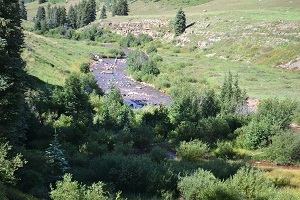“I didn’t know that Trout Unlimited did that!” This was the phrase I heard mentioned by a couple of students and professors during a tour I conducted of the Kerber Creek Restoration Project on June 4, 2013. The tour focused on various stream restoration projects and techniques that have been on-going in the watershed since 2008. Several students from the University of Colorado, Colorado Springs (UCCS) and Colorado College (CC) visited Kerber Creek outside of Villa Grove, Colorado as part of their course curriculum, and were accompanied by a professor from each school. I was contacted earlier in the year by one of the professors to conduct a watershed tour of Kerber Creek so I developed a plan that would give the students a good overview of the legacy mining issues that created the problems existing today throughout the watershed.
Back to the initial phrase. You would be surprised how many people think TU is “just a fishing club.” However, TU’s national staff is composed of 183 passionate individuals that strive to conserve, protect, and restore North America’s coldwater fisheries and their watersheds, most of whom also love fishing. My program specifically targets Colorado watersheds affected by legacy hard-rock mining, like Kerber Creek, Lake Fork of the Arkansas, and Clear Creek.
 I started the tour at the Cocomongo Mill/Mine in the upper watershed, which provided a good representation of where and how historic mining operations took place, and the mine wastes/tailings commonly left behind. I explained the mining and milling processes and provided background information about the Bonanza Mining District. The setting included a large mill structure surrounded by piles of multicolored mine wastes within the Kerber Creek corridor. The students were captivated by the site and eager to learn more about the restoration techniques used to improve these conditions.
I started the tour at the Cocomongo Mill/Mine in the upper watershed, which provided a good representation of where and how historic mining operations took place, and the mine wastes/tailings commonly left behind. I explained the mining and milling processes and provided background information about the Bonanza Mining District. The setting included a large mill structure surrounded by piles of multicolored mine wastes within the Kerber Creek corridor. The students were captivated by the site and eager to learn more about the restoration techniques used to improve these conditions.
The next stop was near the confluence of Brewery Creek and Kerber Creek where 32 in-stream rock structures and 2.14 acres of mine waste reclamation had taken place the year prior. This site showcased what is possible when local stakeholders work together with government agencies and non-profit organizations. The students enjoyed seeing the finished structures and had countless excellent questions regarding rock structure type and purpose, soil amendment quantities and mixes, and grazing management techniques.
On the way down through the watershed we stopped at several sites, such as the repository that was completed in 1999, as well as past and future locations that exemplify the work accomplished through the Bonanza Stakeholder Group partnership, which is a collaboration of 16 federal, state, and local agencies, non-profit groups, and m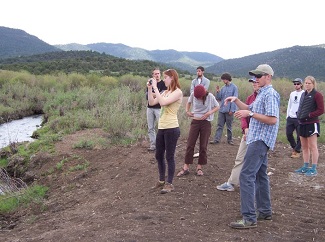 ore than 20 local landowners. The final stop was at one of the largest private landowners in the lower watershed where work is taking place this fall. This site provided examples of existing mine waste deposits that were distributed throughout the floodplains during high flow events when tailing dams were breached in the 1900’s. The toxic mine waste deposits contain little to no vegetation and cannot sustain the high flows associated with spring runoff and summer storm periods. This leads to unstable banks that erode, widening the stream, and eventually disconnecting the floodplain from the stream.
ore than 20 local landowners. The final stop was at one of the largest private landowners in the lower watershed where work is taking place this fall. This site provided examples of existing mine waste deposits that were distributed throughout the floodplains during high flow events when tailing dams were breached in the 1900’s. The toxic mine waste deposits contain little to no vegetation and cannot sustain the high flows associated with spring runoff and summer storm periods. This leads to unstable banks that erode, widening the stream, and eventually disconnecting the floodplain from the stream.
Conditions present at this site provided the students with a “before and after” glimpse of stream restoration. The entire site was walked from the degraded section, downstream to a recently restored segment that included in-stream rock structures and willow transplants. I was impressed by the quality of questions and general interest of the students. I could tell that they were genuinely interested in the project and excited to be in the field observing actual conditions. The tour concluded with a question and answer portion that included questions about the history of the watershed, background information, and restoration procedures. Each correct answer yielded praise from fellow students and the grand prize of a………TU t-shirt!
 The tour consisted of a unique group of students in that a majority of them were pursuing different forms of environmentally based degrees. In my opinion, this proved for a well-rounded tour and a broader range of questions asked by the students. It was great to see that they really appreciated the tour and the opportunity to see actual stream restoration. TU would like to thank both programs of CC and UCCS for the opportunity to help educate and inform the students about the importance of preserving our local ecosystems and watersheds. If the group that attended this tour is any indication of the quality of future ecologists, engineers, biologists, and scientists then I feel inclined to say that successful efforts to conserve, protect, and restore North America’s coldwater fisheries and their watersheds should continue for years to come.
The tour consisted of a unique group of students in that a majority of them were pursuing different forms of environmentally based degrees. In my opinion, this proved for a well-rounded tour and a broader range of questions asked by the students. It was great to see that they really appreciated the tour and the opportunity to see actual stream restoration. TU would like to thank both programs of CC and UCCS for the opportunity to help educate and inform the students about the importance of preserving our local ecosystems and watersheds. If the group that attended this tour is any indication of the quality of future ecologists, engineers, biologists, and scientists then I feel inclined to say that successful efforts to conserve, protect, and restore North America’s coldwater fisheries and their watersheds should continue for years to come.
- Jason Willis, Mine Restoration Field Coordinator
Colorado Abandoned Mines Project, Trout Unlimited

